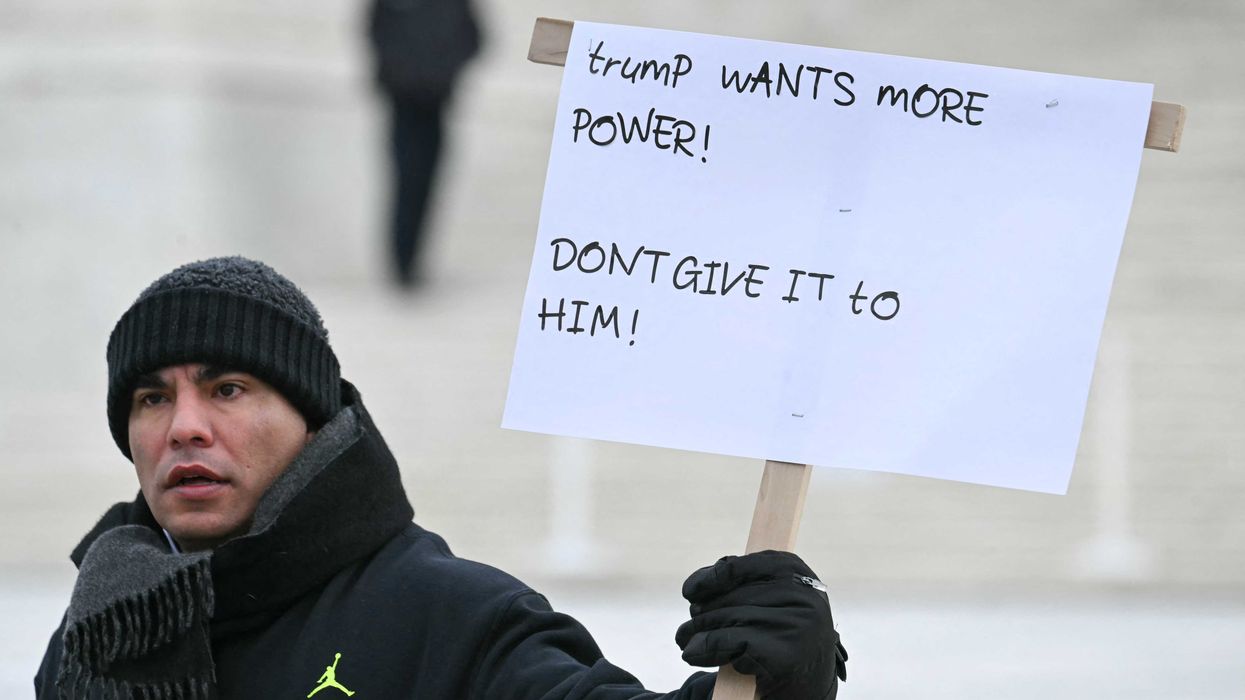GLENN: So I saw something yesterday I thought had to be joke. It's really not.
STU: Yeah. Because you seem to be joking a lot so far in the show.
GLENN: I know. I know.
STU: You're mocking people who were screaming helplessly at the sky. But what are you supposed to do in a culture that allows legal chain saw bayonets on their guns?
GLENN: Right! Am I right?
STU: Right? And you might think it's a joke. You might think it's some silly thing. I don't know. But, I mean, I can tell you this. It scared the hell out of me when I saw it yesterday from USA Today.
GLENN: Okay. So USA Today put out a video of all of the attachments. Like a flash light. Good God, you could put a flash flight on the end of a gun. Why would someone ever need something like that?
STU: It's almost as if you'd want to see where the bullets were going.
GLENN: See what's in front of you. It's crazy these -- then they showed a laser site.
STU: Uh-huh.
GLENN: Hello. Does anybody remember Dr. Evil? What was he putting at the top of sharks' heads? Lasers.
STU: So that is really -- they actually did do this video, if you haven't seen it. First, they go through the actual attachments that were on the gun, that the shooter used. Then they go through some other possible attachments that are available.
GLENN: That are available.
STU: Yeah.
GLENN: And people do this, they put lasers on their guns.
STU: It says possible modifications. One hundred round drum magazine. They also have a shotgun attachment.
GLENN: A shotgun attachment.
STU: So you had attach another shotgun below the gun.
GLENN: A shotgun attachment, now, that is not something I've seen before. But if it's in USA Today, it's a shotgun attachment. I get that.
STU: And, of course, most terrifying is the chain saw baneet.
GLENN: Don't even say that out loud.
STU: Well, I unfortunately have. So it's impossible to stop now.
GLENN: I wish you hadn't. Because once people get the idea that this is available, that you can go out in a store and you can buy an attachment for your AR, and it's a chain saw and you just mount that chain saw underneath the barrel so it's -- it's a chain saw bayonet. My gosh, do you know the kind of carnage?
STU: Oh, my gosh. Everyone is going to have one by the end of the week. And that's what's terrifying to me. You know, I used to be for the Second Amendment. Then chain saw bayonet.
GLENN: So now let me just say that I don't think -- and I'm doing something at 5 o'clock tonight that I believe -- we're going to take you through the fantasy land that Hollywood lives in. Because I don't think that they can find the difference between truth and fiction. I really -- you know, it's like these actors who are like, well, when I was climbing the -- the Himalayas with HEP Niblick. With who?
He was my Sherpa guy. That was a movie, man. That was a movie. And they have no idea the difference between real life and movies and fiction. George Takei yesterday tweeted out how in the United Federation of Planets, they had universal health care.
George, I want you to -- I'm not sure if you're aware of this, but the United Federation of Planets, doesn't exist. It's a TV show.
STU: It's also movies.
GLENN: Yeah.
STU: So...
GLENN: So.
STU: Back up. Second source there. That's how it works, right?
GLENN: When you're right, you're right.
So when I saw the chain saw bayonet --
STU: Hmm. Terrifying.
GLENN: First of all, I was like, I've got to get me one of them.
STU: I actually think I do want one if they exist.
GLENN: And then the second thing that I thought of is this -- the people that are telling you that guns are evil are so disconnected from reality, that they actually think that there is a movement to attach chain saw to ARs. That that is something -- you know, I'm --
STU: I'm going to Cabela's.
GLENN: I'm going to Cabela's. I'm just going to grab a chain saw attachment, honey. I'll be right back.
STU: That's like a totally normal thing to them.
GLENN: Right. That they would attach them. And they would -- it's ridiculous to believe. So we started to look into it. The gun exists. And I have it.
STU: You do? And this is -- by the way, do not try this at home. Because this is a very dangerous weapon.
GLENN: This is the actual gun, that they are basing -- and I'm not kidding you. This is the gun that they're basing that attachment on. And as you see, Stu, I don't want to point it to you.
STU: Please don't. It's very scary.
GLENN: I'm putting it at the camera. You will see that this is an AR.
STU: Oh, my gosh. I don't know if it's an actual --
GLENN: And right underneath it's a chain saw.
STU: Now, some would say that potentially, that gun seems to come from the video game games of war -- Gears of War.
GLENN: That's what some would say. What's the difference between real life and a video game?
STU: Apparently to many in the media, nothing.
GLENN: Exactly right. Exactly right.
This is from the video game --
STU: And a lot of people actually think that's where they got that idea. It's a popular video game from the '90s.
GLENN: Where else would you get that idea? Have you ever heard of that?
STU: I've never heard of that. There's a few YouTubers who have sort of jokingly attached, you know, chain saws to guns. I guess they then use the chain saw. But it's not like it's an actual functional thing. There's no reason --
GLENN: Oh, my gosh, Stu, you are so stupid. I am going to -- you know what, could we get -- here, here, I got it. I got it.
I brought in a few things today.
STU: He brought in a few things, he's across the room now.
GLENN: So I brought in the AR.
STU: Okay. Be careful with that.
GLENN: Okay. All right.
Yeah, no, I know. I brought the AR in. And I brought in a chain saw.
STU: That's a -- and a real chain saw.
GLENN: So I have the AR and the chain saw.
Wait a minute. I've got more.
I also have a shotgun.
STU: Right.
GLENN: Handgun. And some duct tape.
Now, I am -- I am of the mindset.
STU: Uh-huh.
GLENN: That USA Today was on to something.
And I believe that we need to make one of these.
So could we -- is Jason around?
Come here, Jason. Jason is our -- today in-house weapons expert.
Now, Jason, what I would like to do is first I would like to take the AR. And it is unloaded and safe.
I would like you to take the AR, and we want to attach the chain saw right here. Come here. We want to attach the chain saw. Now, I'm left-hand. So I'm going to be shooting like this. So I would like the chain saw right here, so I can -- you know what I mean? So I think it should be like that. Because that's --
STU: Wait. That's not how the design is on the actual chain saw bayonet. The chain saw bayonet from USA Today has it underneath.
GLENN: You know, you can go -- you can go with that. Sure, you can do that.
STU: I have the schematic right here.
GLENN: Yeah, well, I don't want it that way. I want it right there.
STU: You want it on the side basically?
GLENN: They have it like this. Yeah, because I want it on the side. Because I want to be able to chop their heads off.
STU: Wait. The concept of this would be you would shoot the person.
GLENN: You would shoot the person and then you would chop their heads off.
STU: After you've shot them?
GLENN: Sure.
STU: Why would you want -- what's the purpose of chopping their heads off after you've already --
GLENN: Because then there's dead, and then there's, that was sick.
STU: So straight out bloodlust?
GLENN: Oh, yeah.
STU: Making sure.
GLENN: Are you a member of the NRA?
STU: I'm not. So maybe I don't understand real blood lust.
GLENN: Yeah. It's just every member of the NRA knows, I want to shoot something, and then I want to take a chain saw and just hack it up.
STU: Really? Because the guy who was an NRA instructor who stopped the shooting.
GLENN: Yeah, he used one of these.
STU: He used the if one, not the chain saw.
GLENN: Yeah, he used the AR. ARs have to be removed only when killing people.
STU: Right.
GLENN: Except he didn't kill him. He wounded him and stopped the slaughter with his AR. But pay no attention to that. You know, because he didn't kill him.
STU: A lot of people aren't paying attention to him, it seems like.
GLENN: Yeah. So he had just the AR. But I'm going to have the AR with just the attachment. Okay? So can we work on that right now? Can you just take that over there? Because I'd got some other attachments that I would like to add to it as well.
For instance, Stu, what is this?
STU: Well, that's a knife.
GLENN: A knife. What kind of knife is it?
STU: I would say steak knife.
GLENN: That's what you would think.
STU: Looks like a steak knife to me. Is that what it is?
GLENN: Yeah. That's it. Just a regular knife.
I don't want you to freak out. I don't want you to freak out.
STU: Okay.
GLENN: But what is this?
STU: That appears to be another knife.
GLENN: Another knife.
STU: It's slightly larger. It's like a butcher knife. Not quite --
GLENN: So a butcher knife. Okay.
You don't see the difference here?
Besides the size. Oh, my gosh.
STU: What's the -- it looks like --
GLENN: What is this?
STU: That's like a butcher knife.
GLENN: That's a butcher knife, right?
STU: That's a butcher knife. Regular butcher knife, right?
STU: Yes.
GLENN: Does it make you afraid.
STU: No, we have them --
GLENN: What's this?
STU: Basically a butcher knife. I don't know the exact at the table term of that knife.
GLENN: But it makes you afraid?
STU: No.
GLENN: Yes, it does.
STU: It does?
GLENN: This one is spray-painted black. (?) this is a tabling knife. This is a steak knife. This doesn't make you afraid. This doesn't make you afraid. But I spray pained this one black, so it's now a tactical knife.
Don't you --
STU: But would they all be sharp and dangerous and stab you in the same --
GLENN: Yeah, but this one is more frightening.
STU: Okay.
GLENN: I come at you with this.
STU: Oh, that's just a normal silver knife.
GLENN: He's just going to come at me and maybe we're going to butcher some meat together. I believe at you with this, (?), but I come at you with this, and you know I have deadly intent.
STU: That's true.
GLENN: And I'm a serial killer.
STU: Right. Because it's painted.
GLENN: It's pained black.
STU: Okay. Now I'm getting it. (?)
GLENN: Good. We need to put the tactical knife. I was thinking, if we put -- except, I don't like the look of the tactical (?)
STU: It's just silver.
GLENN: No, it's just silver.
STU: That part is just scary.
GLENN: That part is scary. If I came (?) then you would be terrified.
STU: But you had the barrel.
GLENN: As soon as I put the barrel, and you see it's silver, you're like --
STU: It's not a big deal. By the way, that is essentially the subscription of the new Feinstein bill. It's basically her new (?) is it a black weapon? Then it must be banned.
GLENN: Wow. Racist. Listen to the racism.
STU: That's typical progressives.
GLENN: Hey, can I have some of that duct tape. Because I'm going to show you here at home, if you happen to be listening, you can go to TheBlaze TV and capture this sometimes later today, in case you want to make some of this yourself. But I'll try to be very descriptive on radio. But, again, if you can't follow this, and you want to get this exactly right --
STU: And we're getting this live on Facebook. Stu Burguiere on Facebook. (?) you can see this happen.
GLENN: You take a Smith & Wesson here. Okay? Regular Smith and resin. Because I can carry this. I'm going to show you how to make a concealed weapon with an at home attachment to make it a little more sick.
STU: Oh, my gosh. And this is legal, right?
GLENN: Oh, this is totally legal. Totally legal.
STU: Because the NRA. The freaking NRA.
GLENN: We'll do that just a second. (?)
STU: No, it's just silver.
GLENN: We'll go through all this. Because I'm an NRA member. And I know. And we'll also show you the finished product of the real chain saw AR coming up in a second.

 JIM WATSON / Contributor | Getty Images
JIM WATSON / Contributor | Getty Images
 Joe Raedle / Staff | Getty Images
Joe Raedle / Staff | Getty Images AASHISH KIPHAYET / Contributor | Getty Images
AASHISH KIPHAYET / Contributor | Getty Images Harold M. Lambert / Contributor | Getty Images
Harold M. Lambert / Contributor | Getty Images